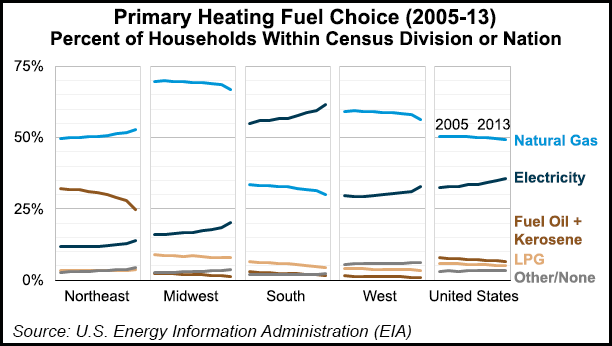EIA: Excluding Northeast, NatGas Losing Market Share for Heating
Natural gas continues to be the primary source of fuel for heating at the national level, but excluding the nine states that comprise the Northeast Census region, gas is starting to lose ground to electricity, according to the U.S. Energy Information Administration (EIA).

In a “Today in Energy” brief released Thursday, EIA said gas, distillate fuel oil, kerosene and propane have seen their market shares decline nationally in recent years, while electricity’s share has increased.
“Part of the national change in heating fuel choice can be attributed to population migrations farther west and south,” EIA said. “But even within Census regions, electricity has been gaining market share at the expense of natural gas. The Northeast is the exception, as both natural gas and electricity have been increasing while distillate fuel oil and kerosene have declined.”
According to EIA, most homes in the 12 states that make up the Midwest Census region are heated by natural gas, and the region also has the highest percentage of homes heated by propane. But both fuels have lost market share to electricity since 2005.
Electricity is the top fuel for heating only in the South Census region, which includes 16 states plus the District of Columbia. EIA said that in the 13 states that comprise the West Census region, fuels used for heating tend to follow the national average, but it added that some households there “are more likely to use wood as their primary heating fuel or to report not using heating equipment at all.”
EIA attributed part of the shift toward electricity to improvements in electric heat pump technology. The units are now more efficient and have an extended range of temperatures in which they can operate before a backup heating element kicks in.
“Heating fuel choice reflects decisions made by home builders and owners,” EIA said, adding that its data shows that homes built since 1970 “use electricity and natural gas as their main heating fuel in roughly equal proportions.” Both electricity and natural gas were used in 42% of homes built between 1970 and 1989. Electricity slipped ahead, 44% to 43%, for homes built between 1990 and 2009.
“Often the choice of heating fuel in new construction has long-term implications, as fuel switching can be expensive. In addition to buying new equipment and removing old equipment, ductwork, pipes, flues, pumps and fans may need to be installed or removed.”
EIA added that space heating is the largest portion of household energy use in most areas of the country. The selection of the main heating fuel also influences what fuels are chosen for tasks such as water heating, cooking and clothes drying.
The agency said that the most recent data from its Residential Energy Consumption Survey shows that homes using natural gas as their main space heating fuel “are more likely to also use natural gas for other purposes. Nationally, only 20% of clothes dryers use natural gas, but in homes with natural gas as their main space heating fuel, that percentage increases to 34%. Of the homes using electricity as their primary heating fuel, about 96% used electric clothes dryers.”
© 2024 Natural Gas Intelligence. All rights reserved.
ISSN © 1532-1231 | ISSN © 2577-9877 |
